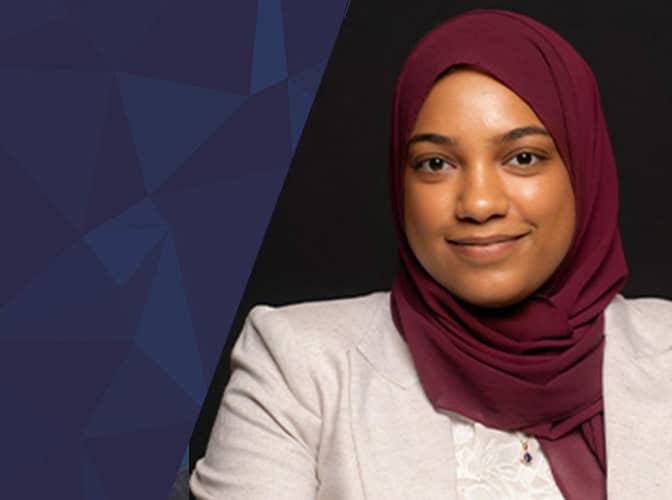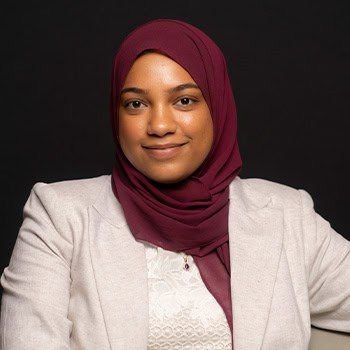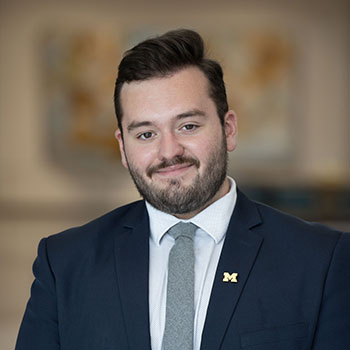
Introducing Rabab Haider to U-M CEE
Haider’s research centers around energy and power systems and their design and operation in a decarbonized future.

Haider’s research centers around energy and power systems and their design and operation in a decarbonized future.

Incoming Assistant Professor Rabab Haider comes to the University of Michigan from the Georgia Institute of Technology’s School of Industrial and Systems Engineering and the NSF Artificial Intelligence Research Institute for Advances in Optimization where she was a Postdoctoral Fellow. Before those roles, Haider worked as a research intern studying energy systems modeling and analysis at Microsoft Research and deep learning for predictive analysis at Siemens. Her various academic and professional experiences have significantly shaped the kind of work she is passionate about today.
“Bringing together all of the experiences that I’ve had — working at software companies, working with energy companies — has led me to think about the different ways that the technologies we develop and work with can have real-world impact on the people that we care about the most,” Haider said. “This combination of different people that I’ve had the opportunity to work with and different environments that I’ve worked in that have come together to create this journey towards a CEE pathway.”
Haider’s research centers around energy and power systems and their design and operation in a decarbonized future; her work has involved developing tools in physics-informed machine learning, distributing intelligence for grid-edge devices, and designing future electricity markets. When dealing with energy and power systems, Professor Haider emphasizes the human-centric nature of her work and research — an emphasis that closely aligns with Michigan Engineering’s “People First” strategic vision.
“Energy is an infrastructure system,” Haider explained. “It shares a lot of the properties that we think about when we think of other built infrastructure, like roads, water networks, or city buildings. And when you’re thinking about civil infrastructure, you’re also thinking about the users of that system.”
While at CEE, Haider looks forward to continuing her research and is hopeful for an opportunity to expand her work through interdisciplinary collaboration.
“I’m excited about CEE because it brings people together from different disciplines, specializations, and different backgrounds,” said Haider. “I’m excited about the advancements in systems planning, transportation systems, and digitized cities, and I’m thinking about how we can bring energy and electricity systems into the conversation.”
As Haider continues her energy systems research, she intends to collaborate not only with other CEE and College of Engineering faculty but with the wider U-M community.
“As I come to U-M, I look forward to collaborations outside of the college of engineering as well, including faculty at SEAS, social scientists, or policymakers. Energy system research has to center customer affordability and energy equity to truly achieve the energy transition. This is inherently interdisciplinary,” Haider said.
While at CEE, she aims to include students in her work, from undergraduates to Ph.D candidates. Through the mentorship and connection that comes with working closely with students, Haider will have the opportunity to provide them with experiences and resources that will supplement their classroom learning and growth, helping to guide them toward their passion.
“I’m passionate about working with students, at all levels of their education,” Haider said. “The earlier that students are exposed to new ideas and techniques, and the earlier they’re able to gain diverse experiences inside the classroom and through research programs, the better informed they are in terms of what their interests are and where they want to go in the future. As educators, this is critical to how we support our students to achieve success.”
Haider has plenty of ideas on how to engage students within the classroom as well as outside of it. When discussing her teaching philosophy, she emphasizes the same inclusivity and interdisciplinary thinking that she prioritizes in her research.
“Keeping in mind inclusive teaching practices and the Universal Design for Learning principles are really important to me,” said Haider. “I’ve been participating in training and workshops on those topics, and I’m looking forward to implementing those experiences in the classroom.”
One way Haider plans to implement these teaching philosophies into her classrooms is through the uniquely engaging strategy of “gamifying” education: teaching tricky engineering principles and concepts through educational games.
“With some of these systems or complex equations, it’s hard for students to get a tangible sense for them,” Haider said. “Games can help students see and feel what a change within a system really means, and it gives them an insight into a system that they otherwise can’t interact with. It also presents an opportunity for students to engage with the same material in multiple ways and thus understand it better.”
Looking ahead to her future at CEE, Haider aims to continue her research and keep pace with the rapid changing of power and energy systems. But she also hopes to broaden the scope, generating greater awareness of energy systems and how they impact communities through public outreach and engagement.
“I’m passionate about energy education,” Haider said. “Scaling down all of the technology and engineering that we work with to a human level so that we can engage with people directly is really important in moving forward and helps us see how we touch human lives every single day.”
Learn more about Rabab Haider by listening to our podcast Connections & Directions.

Marketing Communications Specialist
Department of Civil and Environmental Engineering